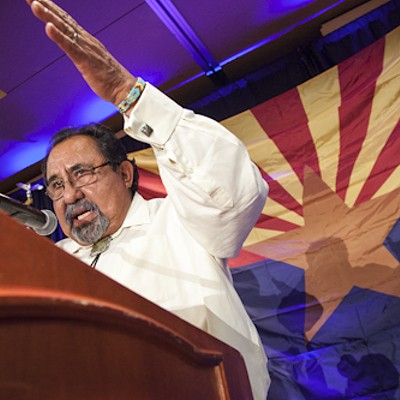With another child on the way, Troy Young and his wife decided to enlarge their small midtown home. But instead of the conventional route, they chose to go green.
"I'm convinced it's a good idea," Young says. "The cost is negligibly higher (but results in an) increased property value and energy savings."
The couple will shortly begin a project to redo their existing two-bedroom house by installing new windows, low-flow plumbing fixtures and a high-efficiency cooling system, plus adding insulation. At the same time, they'll build a 1,100-square foot addition.
Since the city of Tucson didn't have a program for residential green renovations, Young turned to Pima County.
"The process with the county has been great," Young says, "and (program manager) Richard Franz-Ünder was very helpful."
The county's Residential Green Building Program recognizes efforts for both new construction and certain remodeling jobs. Based on criteria supplied on the program's Web site (See www.PimaXpress.com, and click on the "Green Building" tab at the top of the page), points are awarded in six categories, ranging from location to water efficiency.
This latter category gives points for rainwater harvesting and graywater reuse, among other items. Points can also be obtained for not having a swimming pool and not installing an under-sink garbage-disposal system.
Based on the total points awarded, four levels of recognition are available. The program is free for participants, and technical assistance is provided.
"Our system provides the kind of ideas that people might not have thought about," Franz-Ünder says of the county program, "about how to make the home more green."
In addition, he adds: "Participation may help with the resale or original sale of the home".
While the severe downturn in home construction has impacted the number of program participants, there are currently 11 single-family homes and an assisted living facility enrolled, in addition to Young's house.
Participating single-family homeowners, Franz-Ünder says, may be interested in the use of innovative green materials, passive solar strategies and building-frame technologies.
On the other hand, he notes that people developing "green" assisted-living centers may want to concentrate on things such as internal air-quality issues.
That is the case with a project planned for Swan and Fort Lowell roads. Because his assisted-living project is directed at people at least 85 years old, Jerry Sonenblick says: "90 percent of them have respiratory ailments, and my responsibility as the owner is to help people breathe."
To achieve that goal, Sonenblick is participating in another residential green building program offered by Pima County. Coordinated by the U.S. Green Building Council (USGBC), the LEED for Homes Program is also based on a points system awarded in several categories.
"LEED (for Homes) promotes and documents high-performance green homes that are healthier, more comfortable and have lower utility bills," Franz-Ünder wrote about this approach to building.
Whereas the Pima County program is free, participation in the LEED process can cost an individual homeowner a $525 USGBC fee, as well as more than $1,000 to cover expenses associated with Pima County's involvement. Costs per home in a new subdivision can be somewhat lower.
Despite the expense involved, Franz-Ünder says, the LEED program is more popular with homebuilders than the free county alternative; a westside subdivision and two assisted-living facilities are participating.
"People say the national standard is important to them," Franz-Ünder explains.
Going green may be more expensive, at least in the short-term, according to Franz-Ünder.
"You do see some extra costs depending on the homeowner's interest," he says of single-family projects, "such as in water-harvesting and windows."
At the same time, Franz-Ünder continues: "If a subdivision builder takes an existing home plan and says, 'I'm going to green this,' it will cost them more. But if they rethink (how they're doing things) from the bottom up, there's no extra cost involved."
Plus, Franz-Ünder emphasizes, any short-term expense of going green will be greatly offset by lower long-term costs.
"Lifecycle costs are important," he says. "Take windows as an example. Green windows add more value to a house, and they increase energy efficiency."
In addition to these benefits, the USGBC reports that a 2007 Washington state study showed green homes were worth up to 37 percent more than conventional houses and sold considerably faster when put on the market.
Addressing the current status of green home building programs in Pima County, Franz-Ünder says: "People are interested in the concept, but the details can become overwhelming, and documentation needs to be done. So I'm doing a lot of education right now."
As for the future: "My goal is to have 50 percent of all homes (under construction) enrolled in one of the green building programs when we come out of the current downturn," he says.
He's especially interested in the site and location criteria of the two programs, Franz-Ünder says. "If you pick a spot in the middle of nowhere to build, you'll have to work really hard to make up for it in the rest of the point system."
With Earth Day being celebrated soon, Franz-Ünder says about Pima County's green-building programs: "Everybody should be doing this!"












